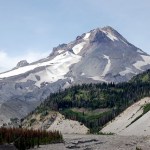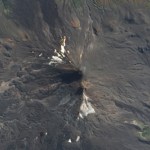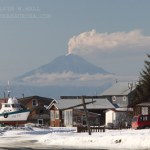united states
This is another busy Wednesday for me as the Geology Dept. at UC Davis will be hosting Dr. Jacob Lowenstern, USGS scientist and director of the Yellowstone Volcano Observatory. He will be giving the weekly seminar, along with another talk in the evening at Sacramento State as part of the Volcanological Society of Sacramento meeting (which is open to the public for those of you around Sacramento). I'm especially excited for the evening talk entitled "Domestic volcanic unrest and activity in 2009: Kilauea, Redoubt, Yellowstone and Washington, D.C.". I'll be sure to report any fun tidbits.
For…
As expected, new potential cases are being investigated in several states, including an additional possible case in Northern California, 2 potential cases in Indiana, a potential case in Ohio and another in Michigan [updated: and some in Massachusetts too]. New York has also confirmed 20 cases now, and 17 more are suspected (check here for additional information--updated as new cases come in and are confirmed or ruled out). Around the world, four in France have apparently tested negative, as have two potential cases in Australia, while 2 in Scotland have been confirmed positive. In Mexico…
Back in the days when Eruptions was on Wordpress, I held a vote about what volcano should be the next to be profiled on this blog. The winner was Mt. Hood in Oregon, and after much waiting, the profile is here. I will actually be out of town until Monday doing some house shopping in this little town. Enjoy this look at one of the most picturesque (and hazardous - #4 in fact) volcanoes in the lower 48 states.
VOLCANO PROFILE: MT. HOOD
Mt. Hood, Oregon in August 2008 taken by Erik Klemetti.
Location: Oregon, U.S.A.
Height: 3,426 m / 11,240 ft
Geophysical location: Along the Cascade arc where…
Has a week gone by already? It is time for another USGS/Smithsonian GVP Weekly Volcano Activity Report.
Highlights (beyond Fernandina, Pagan and Redoubt) include:
A new underwater eruption at NW-Rota 1 in the Mariana Islands.
Increasing seismicity and incandescence from the rhyolite domes forming at Chaiten, Chile.
A spike in sulfur dioxide emissions from Kilauea, Hawai'i to 700 tonnes/day (up from a 2003-07 average of 150 tonnes/day).
4.5-7.5 km / 15-26,000 foot ash columns produced at Shiveluch in Kamchatka from new lava dome.
Continued dome growth and ~6 km / 26,000 foot ash columns from…
Mt. Baker in Washington. Image taken by John Scurlock.
Eruptions reader Robert Somerville brought to my attention the Mount Baker Volcano Research Center, a "clearinghouse for research on Mt. Baker" in Washington state. The center is a non-profit organization that is affiliated with the Geology Department at Western Washington University - and from the looks of the website, they've already done a great job in compiling a lot of information about Mt. Baker, including an excellent eruptive history of the volcano. Mt. Baker is one of the most active Cascade volcanoes, with active fumarolic…
It has been rather quiet on the volcano-front in the last week. Redoubt and Llaima (in spanish), after a few weeks of intense eruption, are both back on Orange Alert. News of the eruptions from Hunga Tonga Hunga Ha'apai and Fernandina is rather sparse in the details. The news of volcanism in 2009 seems to have settled down.
A few tidbits I caught over the weekend:
Chaiten
Damage wrought by the eruption of Chaiten on the town of Chaiten in Chile, taken in early December 2008. Image courtesy of the NASA Earth Observatory.
Don't you feel like you're read this sort of story before after other…
The weekend is rolling in and I might end up spending most of it in the 90+ degree California weather, so unless something big comes up (volcanically), I'll leave you with a few news bits.
Llaima
Llaima in April 2009. Image courtesy of the NASA Earth Observatory
This is a true color image of Llaima in Chile, provided by the great folks at the NASA Earth Observatory. You can clearly see the dark grey new tephra on the main summit cone along with the grey ash covering the snow on the southwestern part of the volcano (north is up). A few other fun features are some smaller parasitic cones in…
Redoubt with a prominent steam plume on April 7,2009. Image courtesy of Robert Cole/AVO
Eruptions reader Brian just pointed out that AVO has posted a new webcam (well, a redirectly webcam) for the volcano and I thought it deserved its own post. This new angle gets you right up to the new dome forming on the volcano. The Hut webcam is now zoomed into the area where new magma is extruding - mostly passively - from this eruption. From this vantage point, when conditions permit - you might be able to get a good view of the dome-collapse block & ash flows that typically accompany silicic dome…
Mount Pagan in the Mariana Islands erupting on April 15, 2009. Image courtesy of the NASA Earth Observatory.
Up until fairly recently, a lot of volcanoes got away with erupting without anyone knowing the better. However, with all the "eyes in the sky" we have these days, even remote oceanic volcanoes get caught in the act of erupting. Case in point is this image (above) of Mt. Pagan in the Mariana Islands erupting. It was captured by the MODIS satellite yesterday and it shows a health ash plume emanating from the volcano. Pagan is an oceanic stratovolcano on the sparsely populated island of…
Just a quick note before I'm off to this ...
Llaima
The SERNAGEOMIN is evaluating whether the alert level at Llaima should be lowered to Yellow in the near future (in spanish). Seismic acitivity at the volcano have come down since the eruptions started a few weeks ago and most of the activity now seems to be fumarolic in nature.
Popocatépetl
Popo (as it is also called) continues to produce steam/gas plumes (in spanish), 5 in one day on Monday of this week. However, all the other usual volcanic monitoring parameters (seismicity and the like) are unchanged according to Cenapred (National…
Redoubt from Ninilchik, AK. Image courtesy of Calvin Hall.
It has been a few days since we've talked about Redoubt. Well, it might be because the volcano has settled down for the past week, to the point that AVO put the volcano back to Orange/Watch status last week and hasn't had to go back to Red/Warning since. This is not to say the Redoubt is quiet, on the contrary, there is still elevated seismicity, an almost-constant steam/ash plume up to 15,000 feet / 5,000 meters and most importantly, the new dome (below) is still growing near the summit. The system has been actively degassing carbon…
Active US volcanoes and volcano observatories
After all the well-publicized words of "a certain governor in the lower forty-eight" (as Sen. Begich (D-AK) likes to call him) the "wasteful" spending on volcano monitoring improvements in the U.S. have become reality. Sec. of the Interior Ken Salazar announced $15.2 million dollars to modern the infrastructure of the nation's volcano monitoring networks (that is out of the ~$3 billion that went to the Interior - making volcano monitoring a whopping 0.5% of the stimulus that went to that department). Much of this money will likely go to one of…
Image courtesy of AVO/USGS taken by Kristi Wallace showing the eruption plume on March 31, 2009.
Today's update will be relatively brief: AVO has returned Redoubt to Orange/Watch status after this weekend's eruptions. The new dome continues to grow and this is accompanied by the usual volcanic seismicity associated with dome construction. We should expect to see the status fluctuate from Orange to Red as the eruption waxes and wanes - and likely get little to no warning of the next big explosive event.
The eruptions of Redoubt has forced Chevron to halt activity for all its Cook Inlet oil…
Image courtesy of AVO/USGS by Cindy Koplin showing the ash fall in Homer, AK on 4/4/09
Not much new to report about the eruption at Redoubt beyond the fact that it continues. AVO has kept the warning level at Red/Warning after briefly dropping it to Orange/Watch on Friday night. The 15,000 foot / 5 km-tall plume on Sunday was mostly water and volcanic gases. Eagle-eyed observers also noticed a plume on the lower flanks on the north side of the volcano that is believed to be steam generated by block & ash flows interacting with snow or water. These flow block & ash flows are coming…
Today looks to be a doubleheader of volcano news:
Redoubt
Image courtesy of AVO/USGS, taken by Rick Wessels. An infrared image of the north slope of Redoubt showing the hot, new dome material and hot block & ash flows confined to the valley.
At 11:30 AM yesterday, AVO put Redoubt back to Orange/Watch alert status after the volcano seem to settle down to small steam/ash plumes. Less than 12 hours later (at ~6:30 AM Alaska time), the volcano produced another large explosive eruption, sending an ash column up ~50,000 feet / 15 km and producing what seems to be a significant lahar that…
Image courtesy of USGS/CVO, taken March 8, 2005 from the Cascades Volcano Observatory, Vancouver, WA
For those of you looking for something to relax with and read this weekend, you could wander over to the USGS website and download yourself a copy (for free and legally) of "A Volcano Rekindled: the Renewed Eruption of Mount St. Helens, 2004-2006" (USGS Professional Paper 1750). The report comes in at a mere 872 pages (that's 697 MB download for the whole report), but you can download the pieces that interest you most as well instead of the whole shebang.
Now, I haven't read the whole thing,…
Image courtesy of AVO/USGS by James Isaak. Photo taken 3/31/2009.
No, this isn't Battlestar Galactica, but the same can be said for the Drift River Oil Terminal: this has all happened before and will all happen again. Coast Guard officials have (finally) decided to move ~6.3 million gallons of crude oil from the Chevron-owned Drift River Oil Terminal at the base of Redoubt. The oil terminal has been a flashpoint since Redoubt began to make noise earlier this year and even up until yesterday, it was unclear what, if any, action the Coast Guard might take with the facility. It had been shut…
Image courtesy of Calvin Hall. Taken 3/28/2009 during an eruption at 10:59 AM3:28 PM.
UPDATE 4/2/2009 at 11 AM Pacific: I'm moving this up from the comments, but Eruptions reader Doug Cole pointed out (and I have no idea how I missed this) that Redoubt has a new webcam! This one is at the DFR seismic station, ~8 miles / 12 km northeast of the volcano. Great views on it today showing the extent of the ash around Redoubt and the steam/ash plume. This view will also be excellent if we get any dome collapse pyroclastic flows (see below).
After a week of explosions and ash fall, Redoubt seems to…
For those of you looking for real volcanic eruption news (no, there was no "Yellowstone eruption"), here is this week's SI/USGS Volcano Activity Report.
And speaking of April Fools Jokes, this is by far my favorite (mostly by its combination of volcanoes and baseball. How could you go wrong with two of my favorite things - hat tip to Fletcher for finding the article).
Highlights (beyond Redoubt) include:
Earthquakes, tremors and steam at El Reventador in Ecuador
12,000-15,000 foot (4-5 km) steam/ash plumes were spotted at Colima, the Mexican volcano.
A shockwave was felt 10 km away from…
Yellowstone Lake eruption, April 1, 2009
Well, after all the seismicity and uplift at Yellowstone caldera over the last few years, something finally happened. Early this morning, without much warning, an eruption occurred in Yellowstone Lake (see above) and sent steam and ash up 50,000 feet above the park. Luckily, no one was injured or killed in the event as we're well ahead tourist season, but it is unknown how this might affect access to the park for this summer.
Now, whether this eruption is really just the caldera "letting off steam" so to speak, possibly in the form of a phreatic…



